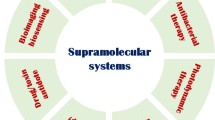Summary
Poly(amidoamine) dendrimers from the zeroth generation (G 0) to the fifth generation (G 5) bearing electron-donating chromophores, i.e. N, N-dimethylphenylamine (PA), carbazole (Cz) and pyrene (Py) chromophores have been synthesized. The macromolecular reactions of chromophoric modifications of PAMAM dendrimers were monitored by fluorescence spectroscopy. The reliability of fluorescence monitoring was confirmed by NMR spectroscopy. Compared with widely applied environment-sensitive fluorescence probe techniques, a distinct feature of the fluorescence monitoring was that it directly reflected the conversion of chemical bonds. A comparative study revealed that the fluorescence quenching of small molecular Py by the high generation dendrimers of PAMAM-PA was a static quenching process. The high generation dendrimers of PAMAM-Py possessed relatively compact Py shells as compared with the same generation PAMAM-PA. Electrochemical studies revealed an architectural transition occurring from an open and flexible structure to a closely packed globular structure between G 2 and G 3. The electron-donating ability of PAMAM-PA was affected by dendritic architectures.
Similar content being viewed by others
References and Notes
Grayson SM, Fréchet JMJ (2001) Chem Rev 101: 3819-3868.
Vicinelli V, Ceroni P, Maestri M, Balzani V, Gorka M, Vogtle F (2002) J Am Chem Soc 124: 6461-6468.
Tsuda K, Dol GC, Gensch T, Hofkens J, Latterini L, Weener JW, Meijer EW, De Schryver FC (2000) J Am Chem Soc 122: 3445-3452.
Adronov A, Gilat SL, Frechet JMJ, Ohta K, Neuwahl FVR, Fleming GR (2000) J Am Chem Soc 122:1175-1185.
Yeow EKL, Ghiggino KP, Reek JNH, Crossley MJ, Bosman AW, Schenning APHJ, Meijer EW (2000) J Phys Chem B 104: 2596-2606.
Baker LA, Crooks RM (2000) Macromolecules 33: 9034-9039.
Stewart GM, Fox MA (1996) J Am Chem Soc 118: 4354-4360.
Storrier GD, Takada K, Abruna HD (1999) Langmuir 15: 872-884.
Yang L, Luo Y, Jia X, Ji Y, You L, Zhou Q (2004) J Phys Chem B 108: 1176-1178.
Wang J, Chen J, Jia X, Cao W, Li M (2000) Chem Comm 511-512.
Zhong H, Wang J, Jia X, Li Y, Qin Y, Chen J, Zhao XS, Cao W (2001) Macromol Rapid Commun 22: 583-586.
Wang BB, Zhang X, Jia XR, Li ZC, Ji Y, Yang L, Wei Y (2004) J Am Chem Soc 126: 15180-15194.
Kim YS, Sook C, Sung P (1995) J Appl Polym Sci 57(3): 363-370.
Pekcan O, Yilmaz Y, Okay O (1997) Polymer 38(7): 1693-1698.
(a) Aspee A, Garcia O, Maretti L, Sastre R, Scaiano JC (2003) Macromolecules 36: 3550-3556, (b) Ballesteros OG, Maretti L, Sastre R, Scaiano JC (2001) Macromolecules 34: 6184-6187.
Grebel-Koehler D, Liu D, De Feyter S, Enkelmann V, Weil T, Engels C, Samyn C, Mullen K, De Schryver FC (2003) Macromolecules 36: 578-590.
(a) Tomalia DA, Baker H, Dewald J, Hall M, Kallos G, Martin S, Roeck J, Ryder J, Smith P (1985) Polym J 17: 117-132. (b) Santo M, Fox MA (1999) J Phys Org Chem 12: 293-307.
Pistolis G, Malliaris A, Paleos CM, Tsiourvas D (1997) Langmuir 13: 5870-5875.
Von Lippert V (1957) Electrochemistry 61: 962-975.
Mataga N, Kaifu Y, Koizumi M (1956) Bull Chem Soc Jpn 29: 465-470.
Lakowicz JR (1999) Principles of Fluorescence Spectroscopy, 2nd ed., Plenum Press: New York, p 239.
To avoid the inner filter effects due to the absorption of the incident light and the emitted light, the fluorescence intensity was corrected as follow: I = Iob x 10[(ODex+ODem)/2]. Iob is the observed fluorescence intensity. ODex and ODem are the optical densities at excitation and emission wavelength, respectively.
Phelan JC, Sung CSP (1997) Macromolecules 30: 6845-6851.
Jansen JFGA, de Brabander-van den Berg EMM, Meijer EW (1994) Science 266: 1226-1229.
Winnik FM (1993) Chem Rev 93: 587-614.
Zhang X, Li ZC, Li KB, Du FS, Li FM (2004) J Am Chem Soc 126: 12200-12201.
Asakawa T, Sunagawa H, Miyagishi S (1998) Langmuir 14: 7091-7094.
Author information
Authors and Affiliations
Corresponding authors
Electronic Supplementary Material
Rights and permissions
About this article
Cite this article
Wang, BB., Zhang, X., Yang, L. et al. Poly(amidoamine) Dendrimers Bearing Electron-Donating Chromophores: Fluorescence and Electrochemical Properties. Polym. Bull. 56, 63–74 (2006). https://doi.org/10.1007/s00289-005-0462-6
Received:
Revised:
Accepted:
Published:
Issue Date:
DOI: https://doi.org/10.1007/s00289-005-0462-6




